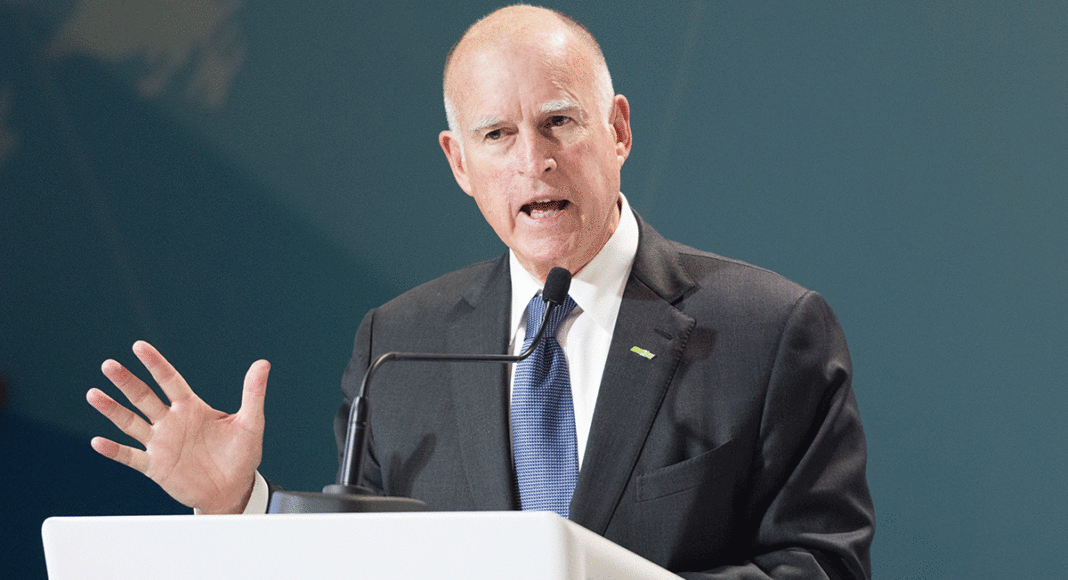In a couple of months, when a new governor is sworn in, a relationship dating back 60 years between the people of California and one particular political family will come to its natural end.
At 80, Jerry Brown is poised to step aside as California’s governor (for the second time), closing a chapter that began when his father, Pat Brown, first assumed the office in 1958. Since then, 40 percent of California’s contemporary history has unfolded with a man named Brown in the governor’s chair.
It’s an intimately familiar story told in wide-angle grandeur in Miriam Pawel’s new book The Browns of California: The Family Dynasty that Transformed a State and Shaped a Nation. Whether you’re a Brown admirer or not, this epic tale belongs on any Californiana-heavy bookshelf next to Kevin Starr and Carey McWilliams.
Conveniently, the story of the Brown family almost exactly parallels the U.S. history of California. The family’s patriarch, German immigrant August Schuckman arrived in California just a couple of years after statehood, in the midst of the Gold Rush.
“I wanted to write a book that was a history of California as much as it was a biography, something that I thought would explain some of the unique and significant things about California,” said Pawel, who visits Bookshop Santa Cruz to discuss her new book Oct. 1.
“The [Brown] family was a good vehicle to do that. I like to write history through people, and so this seemed to be a conjunction between an interesting and unusual family and an interesting and unusual state, and the impact and interplay that each one had on the other.”
Pawel, a Los Angeles Times reporter and native New Yorker who first moved to California in 2000, fills in the colors of the Brown family with compelling secondary characters such as Pat Brown’s freethinking mother and self-described “mountain woman” Ida Schuckman Brown, who died at age 96, in the same year her grandson Jerry was first elected governor.
But mostly, Browns is a story of a father-and-son pair who provide an almost archetypal generational contrast, familiar to many who came of age in post-war America. Pat and Jerry Brown—that is, Edmund G. Brown Sr. and Jr.—were largely simpatico in political values. But in political styles, they could not have been more different.
Pat Brown was an engaging, exuberant, extroverted Hubert Humphrey-style liberal whose love of California was visceral and immediate. Pawel shares Pat’s enthusiasm for flying low in a propeller plane and gazing lovingly at the California landscape, and his habit of stopping in roadside restaurants to glad-hand potential voters. His upbeat personality reflected a kind of post-war optimism that guided him in initiating ambitious and legacy-building projects, particularly in the realms of higher education and water.
By contrast, the former Jesuit seminarian Jerry Brown—at least in his first term as governor, from ’75 to ’83—was more a reflection of the Vietnam/Watergate generation. Aloof, intellectually voracious, almost puritanical in his disdain for mainstream politics, he was the brooding iconoclast who simultaneously hated displays of wealth and loved hanging out with rock stars. Though it was never overt, young Jerry was a walking rebuke of his father’s entire orientation to the world.
But, in a remarkable turn of events to which we’ve all been witness, Jerry Brown—brought low in his first incarnation as governor by Proposition 13, the medfly and his thirst to be president—got a second bite at the apple. As portrayed in Pawel’s book, Jerry 2.0 emerges as a benign synthesis of his father’s human-scale empathy and his own defiant rebelliousness against political inertia. Pat Brown died many years before his son’s second ascent to the governor’s office, but the older Brown would have found the second Jerry Brown administration much more comprehensible than the first.
Jerry Brown was both the youngest California governor since the Civil War, and the oldest one ever. The difference between the two Jerrys, says Pawel, can be attributed to two factors: his tenure as mayor of Oakland in the 2000s, and his 2005 marriage to retail executive Anne Gust. Both rounded off his rougher edges, making him more of a practical and effective politician. Both have given him a new vision to become a compelling counterforce in Donald Trump’s America, and a de facto national leader on such issues as climate change.
“On the other hand,” says Pawel, “he’s still the same person, the same intellect, the same spirit, with the same willingness to challenge authority. How many people get a chance to go back and fix the things they screwed up the first time around? It’s a pretty odd situation.”
Miriam Pawel, author of ‘The Browns of California: The Family Dynasty that Transformed a State and Shaped a Nation’ will speak at 7 p.m. on Monday, Oct. 1, at Bookshop Santa Cruz, 1520 Pacific Ave., Santa Cruz. Free. bookshopsantacruz.com.













